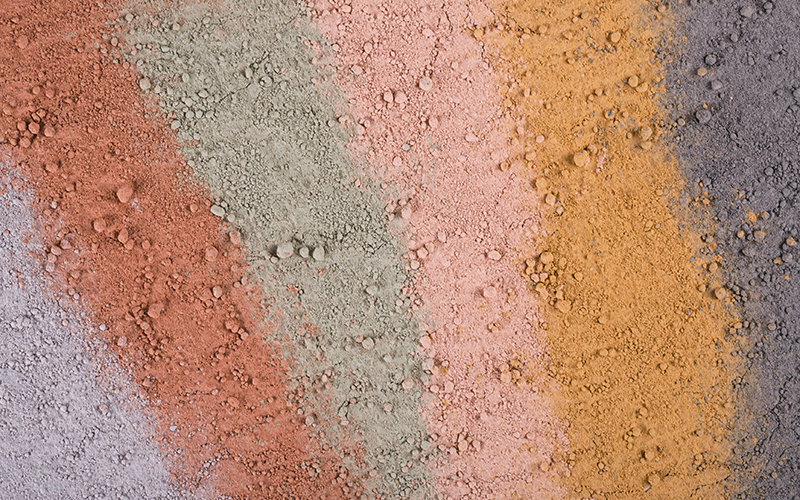Clays are one of the oldest beauty ingredients in the world. From Moroccan hammams to French spas, clay powders have been prized for cleansing, soothing, and beautifying the skin. In today’s cosmetic market, you’ll find clays sold under all sorts of romantic names: French Pink Clay, Brazilian Yellow Clay, Cambrian Blue Clay, and more.
But here’s the catch: those marketing names don’t tell you what you’re actually buying — or how to list it on your ingredient declaration. For compliance, safety substantiation, and consumer transparency, you need to know the actual primary mineral composition of the clay. From that, you can determine the standardized cosmetic name (the INCI name) that you should use in your ingredient declaration.
Descriptive Names vs. Standardized Ingredient Names
Descriptive names are not the same as the standardized ingredient names.
Descriptive Names
French Green Clay or Brazilian Yellow Clay are descriptive names; they are how suppliers identify the ingredients. The descriptive name tells a story: it describes origin, tradition, or appearance. They’re fine to use on the label or in your product description, but they aren’t specific enough to be used in the ingredient declaration.1 In fact, what one vendor may call Rose Clay could be made up of completely different components than what a different vendor calls Rose Clay.
Standardized Ingredient Names
Standardized ingredient names are adopted by the Cosmetic Ingredient Dictionary, published as the “INCI name”, and are the names recognized by regulators. These are the only names that belong in your ingredient declaration.
Natural vs Enhanced Colored Clays
As a general rule of thumb, “natural” clays generally have subdued, earthy colors.
Some suppliers “enhance” their clays to make them more appealing. Common methods include:
- Adding iron oxides to boost red, yellow, or black tones
- Adding ultramarines for vivid blue or purple shades
- Adding synthetic dyes or plant colorants to mimic “exotic” clays
There’s nothing wrong with enhancing a clay to make the colors more alive, so long as all of the components are disclosed so they can be correctly included and listed in the ingredient declaration.
In order to determine what you should use in your ingredient declaration, you need to know what you are actually getting. You should be able to get a Certificate of Analysis or Safety Data Sheet from your supplier, or at the very least, a statement of the components and the correct way to list the clay. If there is more than one component, treat it as a blended ingredient.
If your supplier can’t, or won’t, provide you with that information (or if you have reason to doubt the veracity of the information being given to you), get a different supplier!
Chart of Clays
The following chart shows some of the various clays that are on the market, what their components could be, and how they might be identified in the ingredient declaration. This is probably not a complete list, and is as accurate as I have been able to make it.
You should go by what your supplier tells you, and document it with a Certificate of Analysis.
| Sold/Marketed As | Likely Ingredient Name(s) | Notes for Labeling |
|---|---|---|
| French Green Clay Sea Clay |
Illite, Montmorillonite, Kaolin | True clay |
| Sea Silt | ||
| Illite, Montmorillonite, Kaolin, Iron Oxides | When enchanced with added green iron oxides | |
| Sea Silt, Iron Oxides | When enchanced with added green iron oxides | |
| French Pink Clay Rose Clay |
Kaolin | Naturally tinted by iron oxides |
| Kaolin, Illite | Naturally occuring red illite | |
| Kaolin, Iron Oxides | When enchanced with added red iron oxides | |
| Brazilian Clays (Yellow, Pink, Purple, Red, Natural) |
Kaolin | May be naturally tinted. |
| Kaolin, Iron Oxides | When enchanced with added red, yellow, or brown iron oxides | |
| Kaolin, Ultramarines | When enchanced with added purple ultramarines | |
| Bentonite Clay | Bentonite | |
| Rhassoul / Ghassoul Moroccan Red Clay Moroccan Lava Clay |
Moroccan Lava Clay | |
| Kaolin, Illite | When mixed with illite | |
| Kaolin, Iron Oxides | When enchanced with added red iron oxides | |
| Fuller’s Earth | Fuller’s Earth | In EU and Canada use Solum Fullonum |
| Cambrian Blue Clay Serbian Blue Clay |
Illite, Montmorillonite | Naturally as a blue-gray tone. |
| Illite, Montmorillonite, Ultramarines | Brighter blue, enchanced with added blue ultramarines | |
| Dead Sea Mud | Sea Silt | In the EU and Canada use Maris Limus |
| Illite (Yellow, Red, Green) French Yellow Clay, Red Clay, Illite Cedar Red, |
Illite | Illite clays colored by naturally occuring iron oxides. Color variation does not change the INCI. |
| Illite, Iron Oxides | When enchanced with added red iron oxides | |
| Kaolin Kaolin Clay White Clay China Clay |
Kaolin | Base for many “colored” clays |
Clays as Color Additives
In the US, NO clays are approved as color additives for cosmetics.
In the ingredient declaration, all clays are placed with the regular ingredients, NOT with the color additives which may all be placed at the end of the ingredient declaration. See this Quick Tip: Many Ingredients in Small Amounts.
Iron Oxides and Ultramarines are approved color additives. If your clay color has been enhanced with the addition of Iron Oxides or Ultramarines, they may be listed with the color additives at the end of the ingredient declaration.
- The “old school” method to identify clays in the ingredient declaration was to use the source location. A few of those remain grandfathered in (such as Moroccan Lava Clay). The currently used naming convention is to use the mineral name. ↩︎


Leave a Reply